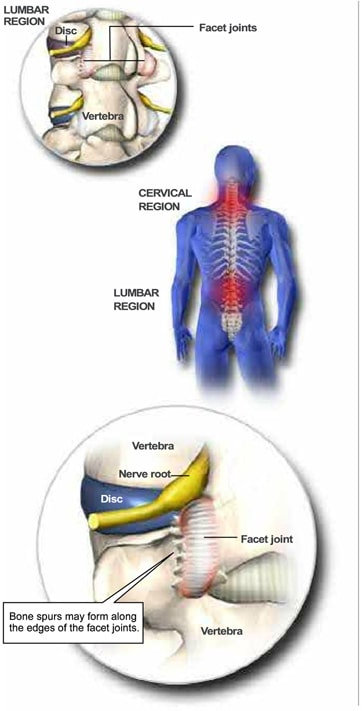Facet Joint Syndrome
Facet Joint Syndrome refers to a condition where your facet joints deteriorate. Your facet joints are paired joints that attach the rear part of one vertebra to those above and below it.
These joints help stabilize your spine and limit excessive motion. The facet joints are lined with cartilage and surrounded by a lubricating capsule that enables the vertebrae to bend and twist.
The root nerves pass through these joints from your spinal cord on their way to your arms, legs and other parts of your body. If your facet joints develop bone spurs or if they lose their structural integrity, the root nerves that pass through them may be squeezed or pinched. This can cause pain and other symptoms.
 FACET JOINT SYNDROME SYMPTOMS
FACET JOINT SYNDROME SYMPTOMS
Pain from Facet Joint Syndrome differs from person to person, depending on which region of your spine is damaged. If the upper (cervical) spine is affected, you may feel pain in your neck and shoulders, as well as in your upper or middle back. You also may experience headaches. If the lower (lumbar) spine is affected, you may feel pain in your lower back and buttocks, as well as in the back of your thighs.
If you have Facet Joint Syndrome, you may have to turn your whole body to look from side to side because of the pain and stiffness you feel. This condition can make it difficult for you to pull yourself out of a chair or stand up straight for any length of time.
CAUSES OF FACET JOINT SYNDROME
There are two primary causes of Facet Joint Syndrome: damage to the joints themselves and loss of cartilage. Joint damage can occur from an injury or illness. Cartilage loss usually happens from wear and tear on the joint.
JOINT DAMAGE
Facet joint syndrome occurs when the facet joints become stressed and damaged. This damage can occur from everyday wear and tear or from an injury to your back or neck. This condition also can develop because an intervertebral disc degenerates.
CARTILAGE LOSS
Like your knee joint, facet joints have protective cartilage that enables smooth movement with little friction wherever two bones meet. Your facet joints also have lubricating joint fluid. If the cartilage gradually wears away, however, the joints become swollen and stiff. Without the cartilage, your vertebral bones rub directly against each other, which can lead to bone spurs along the joint edges.
FACET JOINT SYNDROME DIAGNOSIS
Your Charleston back doctor can diagnose Facet Joint Syndrome by injecting an anesthetic and anti-inflammatory directly into the joint. If you experience immediate pain relief, the cause of the pain is Facet Joint Syndrome.
You can read more information about the safety of spinal injections at the Southeastern Spine Institute (SSI).
FACET JOINT SYNDROME TREATMENT
The conservative physicians at SSI first treat facet joint arthritis with rest, ice, heat, anti-inflammatory medications and physical therapy. They may recommend facet joint blocks, not only to diagnose facet joint pain, but also to treat it. If these non-surgical methods fail to relieve your pain, your doctor may suggest a Facet Rhizotomy or bone fusion as a solution to your pain.

 FACET JOINT SYNDROME SYMPTOMS
FACET JOINT SYNDROME SYMPTOMS